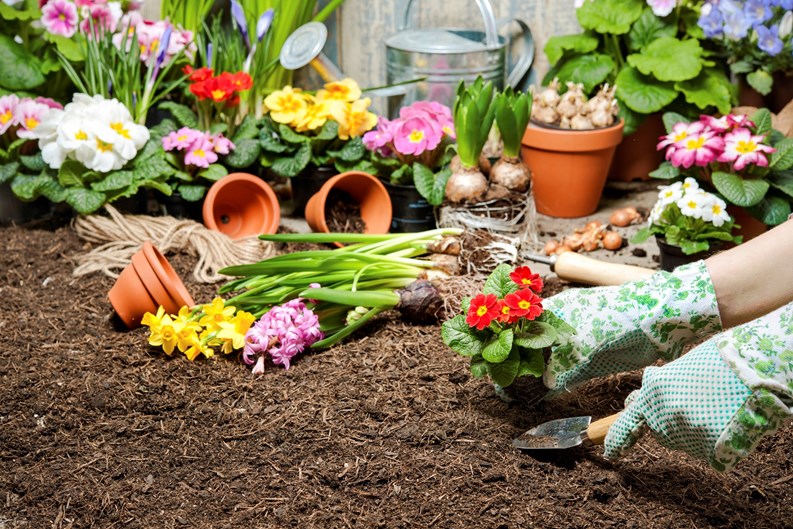New Jersey is the famous Garden State—that population-dense East Coast treasure known for its natural splendor above all else. Who knows more about beautiful flora than green-thumbed denizens of Parsippany, Secaucus, or Ho-Ho-Kus? Nobody, probably. Many New Jersey residents feel the desire to dig their fingers into some dirt, plant a few seeds and watch flowers grow because, along with the coming warm weather, live flowers and greenery have serious mood-boosting power. They also have the ability to liven up almost any façade, and add appeal (and potentially value) to both urban and suburban properties. But, you can’t just slap a fern on your frontage and call it a day. Climate, placement, species, and, you know, how to actually keep the things alive all matter when considering landscaping and planting in urban settings.
What, and Where?
First things first, you’ve got to figure out what is best to plant. As much as you like roses, your desire for them to grow doesn’t mean they are going to grow, let alone thrive, on your small balcony space that gets very little sun but lots of brownish water dripping from the drain pipe above.
“My first question to a board would be, what kind of water system do you have?” notes John Occhipinti, president of Field of Dreams Landscaping in Hawthorne. “Are there areas that aren't irrigated? Because that's going to play a big part as to what flowers will thrive and do well.”
Should irrigation be of short supply, Occhipinti recommends Vinca flowers and lantana. “They're healthy plants, they grow beautifully, and they tolerate the drier weathers.” Were water to be readily available, he suggests impatiens, begonias, and zinnias. “They’ll do very well, and they’re a pretty colorful group of flowers.”
In more urban areas populated with taller buildings, open sunlight is a rarity, and water access can be consistently more difficult to come by than in the suburbs. “We see many spaces in our work that are closed-in, shady courtyard spaces that building residents would like to make lush gardens, but because there is little light and no reliable water access, it can be a challenge to meet those goals,” says Rebecca Bullene, founder of Greenery NYC, a plant garden design company.
Luckily, that doesn’t mean that entire genus and species are out of consideration in city settings. “I think any plants that need a tremendous amount of sun and water like most tropical plants, aren't a good choice,” continues Bullene. “I tend to steer clients away from using too many annual plants as well, as they have to be replaced every year. You'll see much better long-term results choosing the right plant for the right place, planting it once, and watching it grow for years to come.”
How Does Your Garden Grow?
After you’ve selected the appropriate blossoms for your patch of green, think about the real estate itself and don’t try to diversify too much. “Gardens look best when there are groupings of plants, not just lots of different things,” says Jeanette Dragonetti, ASLA, a landscape designer at New York-based Dragonetti Brothers. “Try to make a more natural landscape where there would be areas of five to seven plantings, not individual plant types mixed together in ones and twos. Often the most impressive gardens give a sense of abundance, balance, and lushness, and that is achieved with planting many of the same type of plant in cohesive patterns. Better to have just a few types of plants in your building's entrance garden planted densely than 20 different types all competing for attention.”
You should also take into consideration the irrigation system, say the planting pros. “The most common mistake I find when evaluating a landscape that is not doing well is that the irrigation system isn’t properly coordinated for the plants' water intake—or there's no irrigation system in place at all,” Dragonetti continues. Not enough water, and your garden will die; too much and you’ll drown it. The 'system' also includes factors like best time of day to water (usually the morning so your garden isn’t left damp overnight), using or not using mulch (it can help keep soil moist) and adjusting your watering schedule based on the outside temperature (watering more when it’s hot out, less when it’s cooler).
Gardens are, of course, meant to be admired, but take care not to let your fans trample, trash or—if they have four legs—pee on your plants. “Dogs and people are the biggest threats to plants in front of buildings or within tree pits,” says Bullene. “We often see people litter or let their dogs relieve themselves there, and that can be harmful for plant displays. And of course there is also the occasional well-meaning child picking a flower for mom, which is adorable, but not good for residents trying to bring color to their entrance garden.”
Bullene suggests that when it comes to gardens, lead by example—i.e. prune and tidy for the garden you want, not necessarily the garden you have. “We've found that keeping the area really clean helps signal to people that it is a well-loved space that should be treated well.” She further advises that a layer of mulch two to three inches deep may protect roots from dog waste.
And while Occhipinti says that there aren’t any specific New Jersey predators for which he’d recommend boards be on the lookout, he acknowledges that any local animal can get into gardens and muss them right up at any time. That said, the flowers he’d mentioned above are all very healthy, with the slight exception of the impatient, which, over the last few years, has become afflicted with a fungal disease called downy mildew. “It’s really made normally attractive impatiens look less-than,” he laments. “But specialists have been working on immunizing impatiens. Talking to a horticulturalist friend of mine who raises many a plant, he anticipates that they’re a year or two away from fully defeating it.”
Occhipinti also recommends tilling the ground thoroughly. “Put enough fertilizer in the ground to last you through growing season,” he says. “But note that many flowers available these days already have a slow-release fertilizer, so there’s no need to completely douse them.”
Overall, the success of your succulents, sunflowers and sage depends on “selection, placement and care,” says David Protell, the president of Manhattan-based Chelsea Garden Center. And some of the biggest challenges are faced before you even sink your trowel in the dirt. Protell advises gardeners to really understand the selection process and not assume that “Internet research translates into what you can use. Each garden has its unique sun, drainage, and exposure issues which need to be properly accessed.”
Learn the Roots
Luckily, there are a lot of people out there passionate about perennials and are eager to help aspiring gardeners. “There’s local greenhouses everywhere,” says Fields. “I would just recommend they look online, find a local greenhouse, go check those out. They’ll have a very knowledgeable staff.”
Any properly accredited, professional landscaping firm can offer solid advice for small and large projects, and their responsibility to a co-op or condo building taking on the project is to set realistic goals and a working budget. “Too often, plantings are conceived as an afterthought with no true budget in place,” says Protell. “We have a seven to nine month growing season that could start with hardy bulbs coming up in late March or April, followed by five to six months of flowering annuals, then on to fall and holiday dressing. Building staff following watering instructions and a monthly or quarterly maintenance program will ensure that fertilizing, pest control and pruning are properly implemented. All of the above combine for a successful enhancement of the property.”
In order to get the best result from your relationship with a landscaping firm or designer, Bullene suggests that, before even meeting with a designer, the gardening or landscape committee should meet to outline its goals. “Do they want a space for edibles or growing flowers, or just stately evergreens? Do they want to care for the garden themselves or pay for professional maintenance? Clearly articulating how involved the committee wants to be from the outset can help a designer come up with a plan that best fits the group. If you have a committee of avid gardeners eager to get their hands dirty, a designer can put together a plan that will give them lots to work on through out the season with deadheading and pruning. If you have a committee that doesn't have the time or inclination for that level of involvement, a designer can put together a low maintenance plan that focuses more on evergreen shrubs or plants that grow slowly, or propose a professional maintenance plan.”
That plan will plot out exactly what a year of your garden looks like and the work required to achieve those gardening goals. Bullene explains that a first visit in the spring will assess and clean up winter damage and perform prep work for plans ahead; a second visit in the late spring or early summer is for planting; the third visit in late summer is to trim, tidy and perform up keep and the final visit in the fall is meant to prep for the winter to come.
Truly, the number one ingredient to a healthy garden is patience. Less tangible than mulch and less trendy than a pair of gardening gloves, patience is necessary every step of the way. Add a pinch of consistency and you will most likely be on your way for a picture perfect garden. And, when the first green slivers appear through the soil, as Bullene astutely points out, “It’s worth the dirty work.”
Michael Odenthal is a staff writer for The New Jersey Cooperator. Freelance writer Rebecca Fons contributed to this article.







Leave a Comment